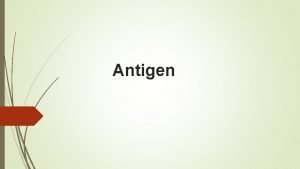Human Leukocyte Antigens Class II alleles impacting the

- Slides: 1

Human Leukocyte Antigens Class II alleles impacting the response to 5 -7 year antiretroviral therapy in a Latvian cohort Vladislavs Jasinskis, Oksana Kolesova, Aleksandrs Kolesovs, Baiba Rozentale, Inga Azina, Ksenija Kramica, Ludmila Viksna, Jelena Eglite The antiretroviral therapy (ART) aims at suppressing viral replication and strengthening individual’s immune system in patients with HIV-1. 21961 The results confirmed significance of an increase in HIV 1 viral load for predicting a decrease in the level of CD 4 cell count. A multiple hierarchical linear regression analysis confirmed that an increase in HIV-1 viral load predicts a decrease in the level of CD 4 cell count. No one allele contributed positively to its change. In addition, HLA-DRB 1*04 and HLA-DQB 1*06: 01 alleles contributed negatively to the level of CD 4 cell count. The Human Leukocyte Antigens (HLA) of the Major Histocompatibility Complex are among factors responsible for effectiveness of ART. The aim of this study was to reveal an impact of HLA Class II alleles on the response to long-time ART by assessing their effect on a change in CD 4 cell count when a change in the viral load is controlled. The sample included 69 patients with HIV-1 infection, who undergoing ART in Latvian Centre of Infectious Diseases. The median period of observations was 5. 7 years. CD 4 cell count and viral load were analyzed at the baseline and end of the period of observation The aim of this study was to reveal an impact of HLA Class II alleles on the response to long-time ART by assessing their effect on a change in CD 4 cell count when a change in the viral load is controlled. The sample included 69 patients (17 females and 52 males) aged 20 to 50 with HIV-1 infection, who undergoing ART in Latvian Centre of Infectious Diseases. The median period of observations was 5. 7 years. CD 4 cell count and viral load were analyzed at the baseline and end of the period of observation. HLA typing was performed by polymerase chain reaction with low resolution sequence specific primers. Among the alleles under investigation, HLA-DRB 1*04 and HLA-DQB 1*06: 01 demonstrated statistically significant association with a decreasing level of CD 4 count over the ART period of 5 to 7 years. These studies pointed at HLA-DRB 1*04 genotype as a HLA marker with an adverse effect in HIV-1 patients. It can be concluded that, as host genetic factors, HLA Class II alleles can affect long-time ART and disease progression. Our study demonstrated that HLA-DRB 1*04 and HLADQB 1*06: 01 alleles are the risk markers in a Latvian cohort of HIV-1 patients undergoing long-time ART. Information regarding patient’s HLA Class II genotype might be helpful to guide ART in patient with HIV-1 infection.

